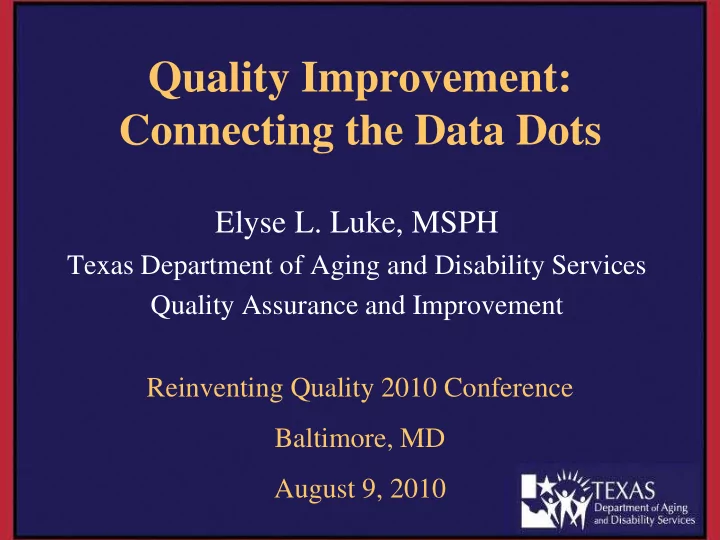

Quality Improvement: Connecting the Data Dots Elyse L. Luke, MSPH Texas Department of Aging and Disability Services Quality Assurance and Improvement Reinventing Quality 2010 Conference Baltimore, MD August 9, 2010
Organization of the Presentation • Texas at-a-glance • Texas Department of Aging and Disability Services at-a-glance • Home and Community-Based Services waiver programs • Continuous Quality Improvement cycle: Texas’ activities in each phase • Lessons learned
Texas At-a-Glance •Population estimate (2009): 24,782,302 •254 counties •11 Health and Human Services Regions
Texas Health and Human Services System At-a-Glance
Texas Department of Aging and Disability Services At-a-Glance Adults and children with intellectual disabilities Additional services Older adults (relocation, (age 60+) and caregivers preventive healthcare) Adults and children with physical disabilities
Continuum of Long-Term Services and Supports (Hewitt et al., 2008) Home and Community-Based Settings Institutional Supports to Non-Residential Community Individuals and Community Settings Residential Families Supports 24-hour Day programs and residential Home health care rehabilitative or supports and medical supports services Nursing State- facilities and Personal care operated Less than 24- residential services (agency- institutions hour rehabilitation directed) Job or vocational residential services Personal care supports and services (consumer- services directed)
Home and Community-Based Services Waiver Programs in Texas Waiver # served/ month (2009) Community-Based Alternatives 25,927 Home and Community-Based Services 17,255 Community Living Assistance and 4,385 Support Services Medically Dependent Children Program 2,699 Texas Home Living Waiver 994 Deaf Blind with Multiple Disabilities 150 Consolidated Waiver Program 159 Integrated Care Management 100
Continuous Quality Improvement Design Improvement Quality Remediation Discovery
Design a Quality Improvement System • Where do we get data from? • Do we have the kind of data we need to ask questions about quality? • If we need additional information, how do we get it? • Where and how should we store the data? • How do we get information out of the system? • How will we use information from the system?
Where Do We Get Data From? Quality Participant Other Sources Assurance and Surveys Improvement •Agency- Data Mart •National Core initiated research Indicators •Agency data •Peer-reviewed •Participant literature •Texas Health Experience and Human Surveys •Government Services reports enterprise data
Putting the Data Together in One Place: QAI Data Mart New data (contract Service provider monitoring, information DFPS) Social Security Administration •Nursing facilities (death data) QAI •Nursing waivers Data Mart •IDD Waivers •HCBS Waivers •Residential services •Interest lists Medicaid & Healthcare (claims processed, vendor drug)
Discovery Using Data QAI Participant Data Surveys Mart √ √ Snapshot of services and supports √ √ Analyze trends over time √ √ Compare groups √ √ Identify areas for quality improvement √ √ Examine participant outcomes √ Individual-level information √ Examine processes and impact of policy
Remediation of Individual Quality Issues Prevalence of Restraint use in Nursing Facilities 25% 19.5% 20% Percent (%) 15% 10.7% Improvement 8.8% Discovery 10% 7.6% 6.0% 3.9% 5% Remediation 0% 2002 2003 2004 2005 2008 2009 Year
Quality Improvement System-Wide Quality State or National Participant Assurance and Initiatives Surveys Improvement •Quality Oversight Plan Data Mart •Consumer Directed •Direct Support Workforce Services •Quality Reporting System •Advisory Councils (Promoting •Preventive care in Independence, Autism, Consumer nursing facilities •Quality Matters Directed Services) Website •Culture Change in nursing •CMS Assurances facilities •Performance-Based Contracting
Lessons Learned • Data provides information about the people we serve so we can identify and remedy problems to improve outcomes, quality of care, and processes. • Quality improvement begins with designing a comprehensive, reliable data system. • Creating a data repository is challenging with multiple programs that have different rules and operational systems. • Design, Discovery, Remediation, and Improvement processes occur simultaneously. • Improving quality takes time and coordination.
Reference Hewitt, A., Larson, S., Edelstein, S., Seavey, D., Hoge, M.A., & Morris, J. (2008). A synthesis of direct service workforce demographics and challenges across intellectual/developmental disabilities, aging, physical disabilities, and behavioral health . Retrieved from http://rtc.umn.edu/docs/Cross- DisabilitySynthesisWhitePaperFinal.pdf
Contact Information Elyse L. Luke, MSPH Program Specialist VII Email address: elyse.luke@dads.state.tx.us Phone: (512) 438-4424
Recommend
More recommend